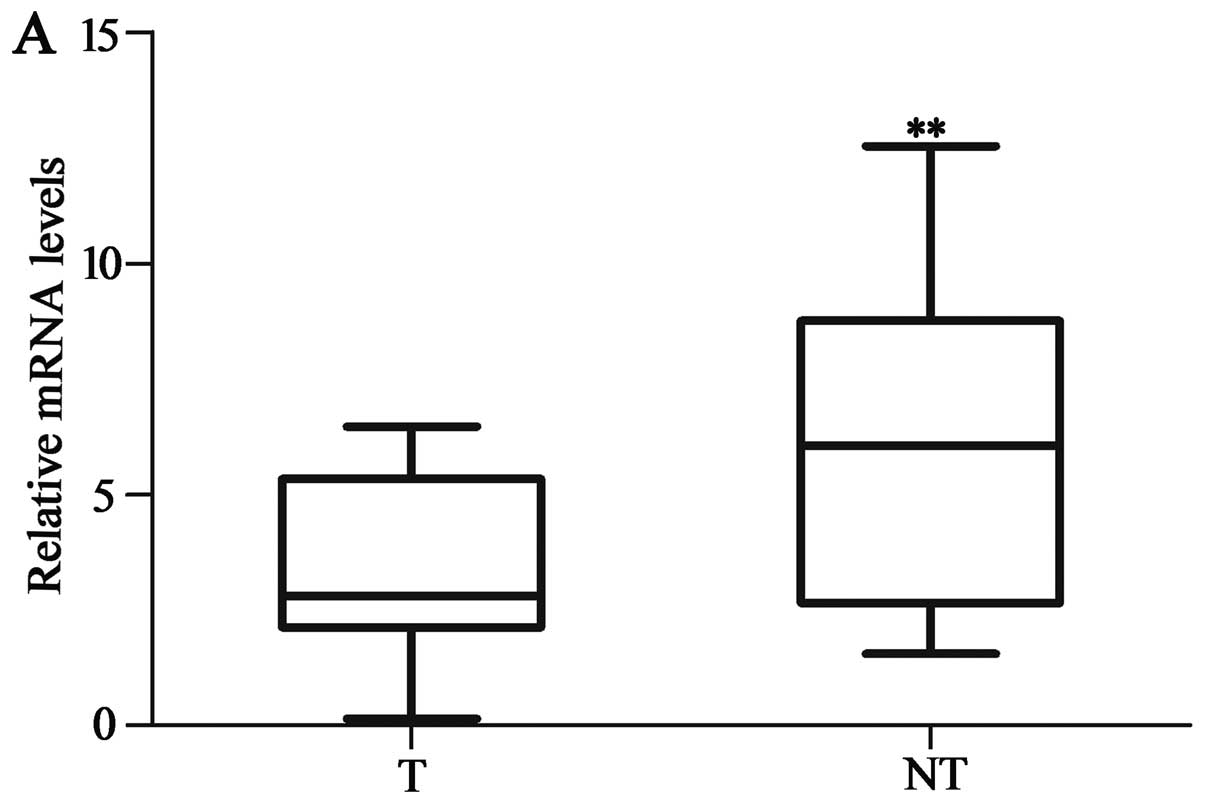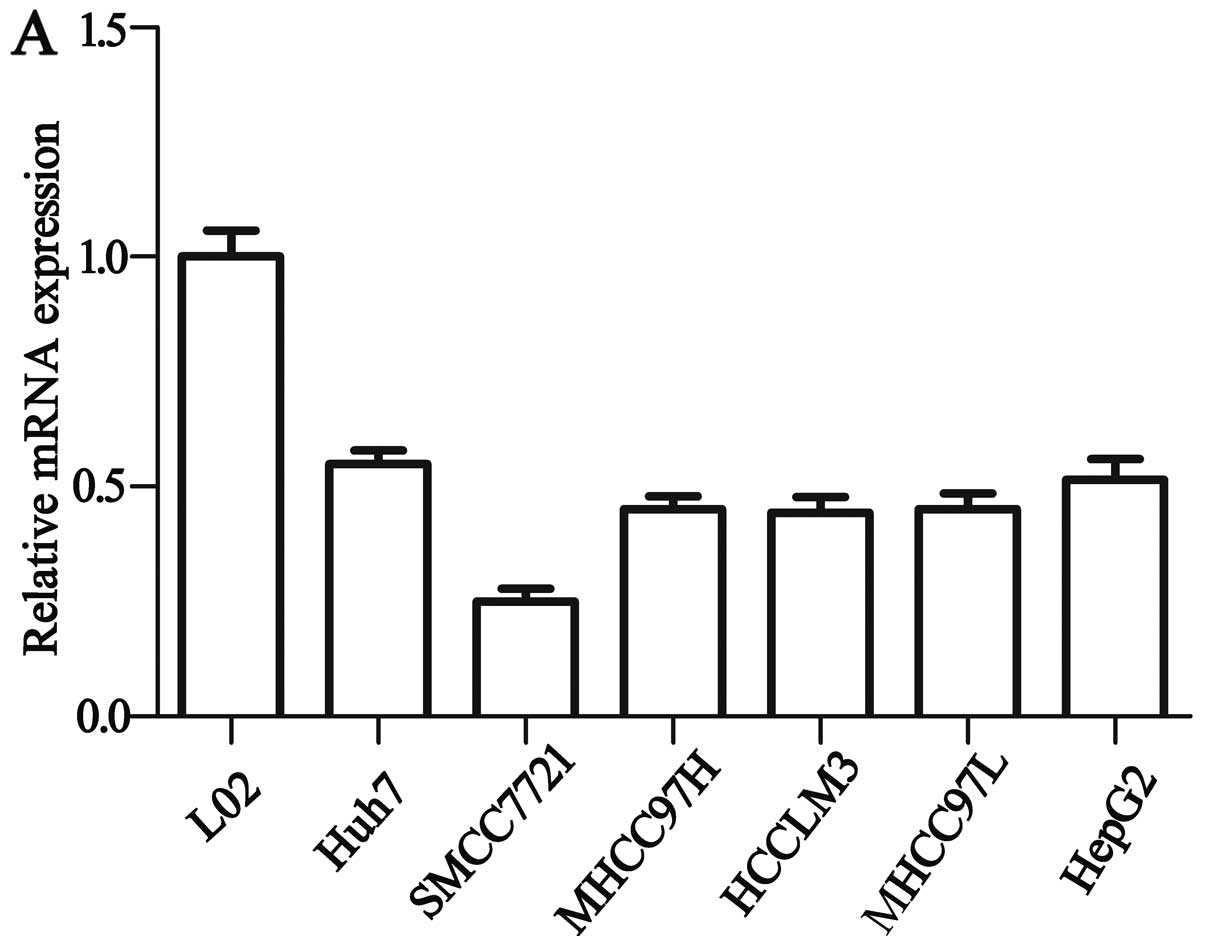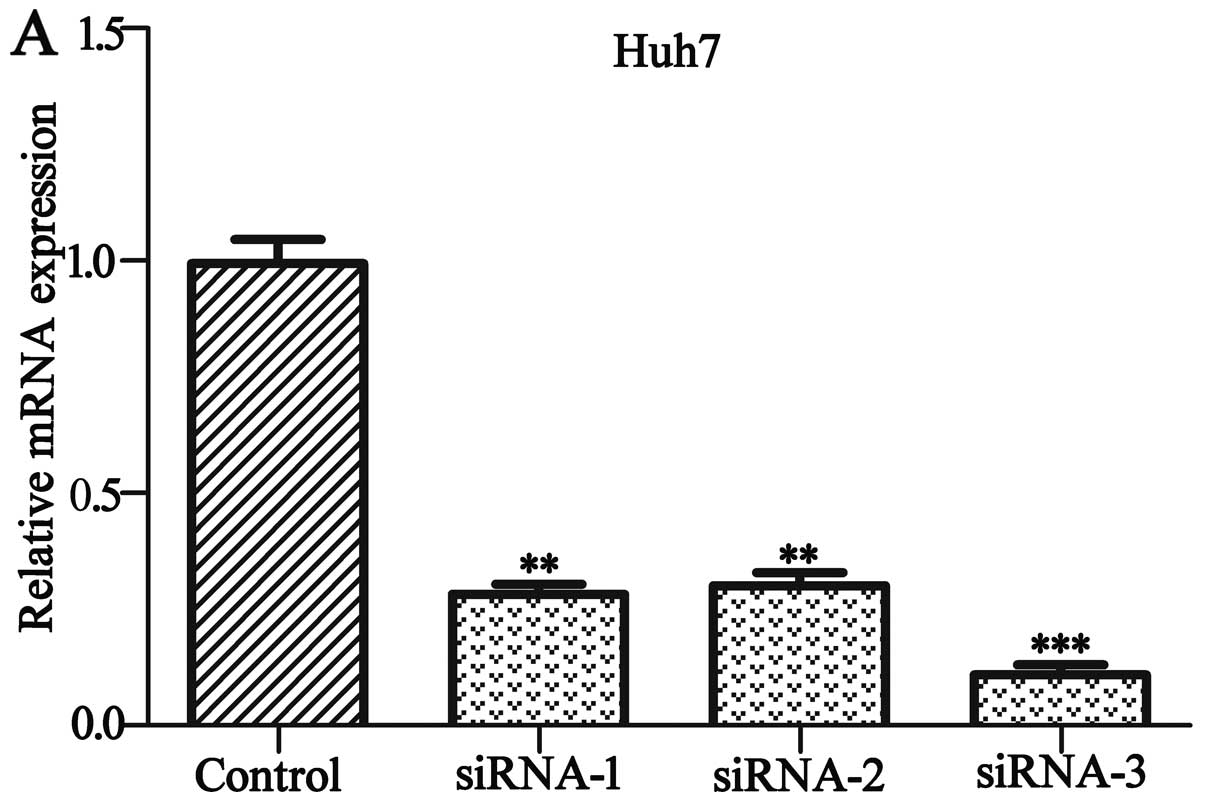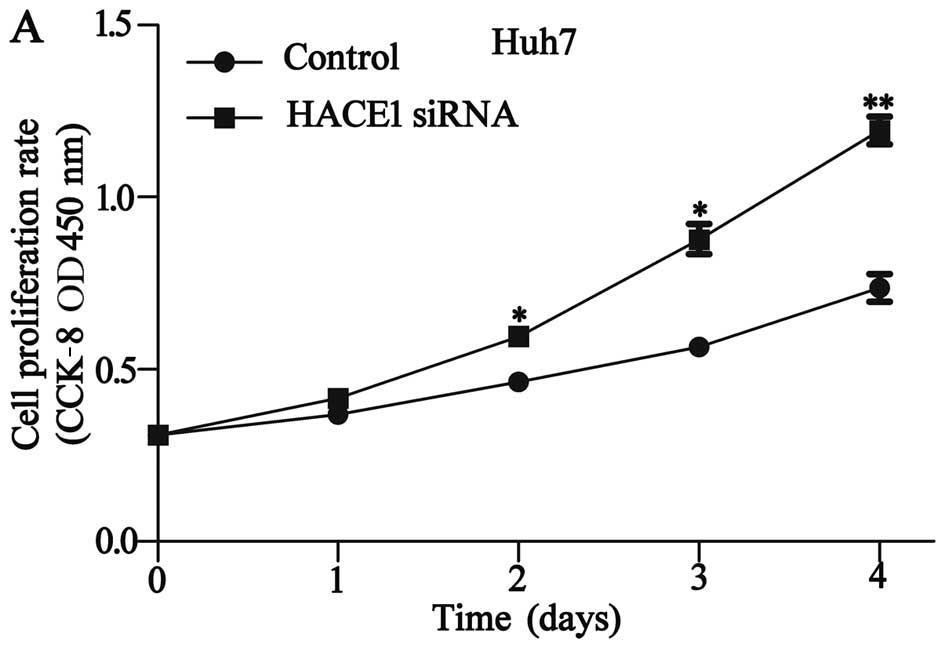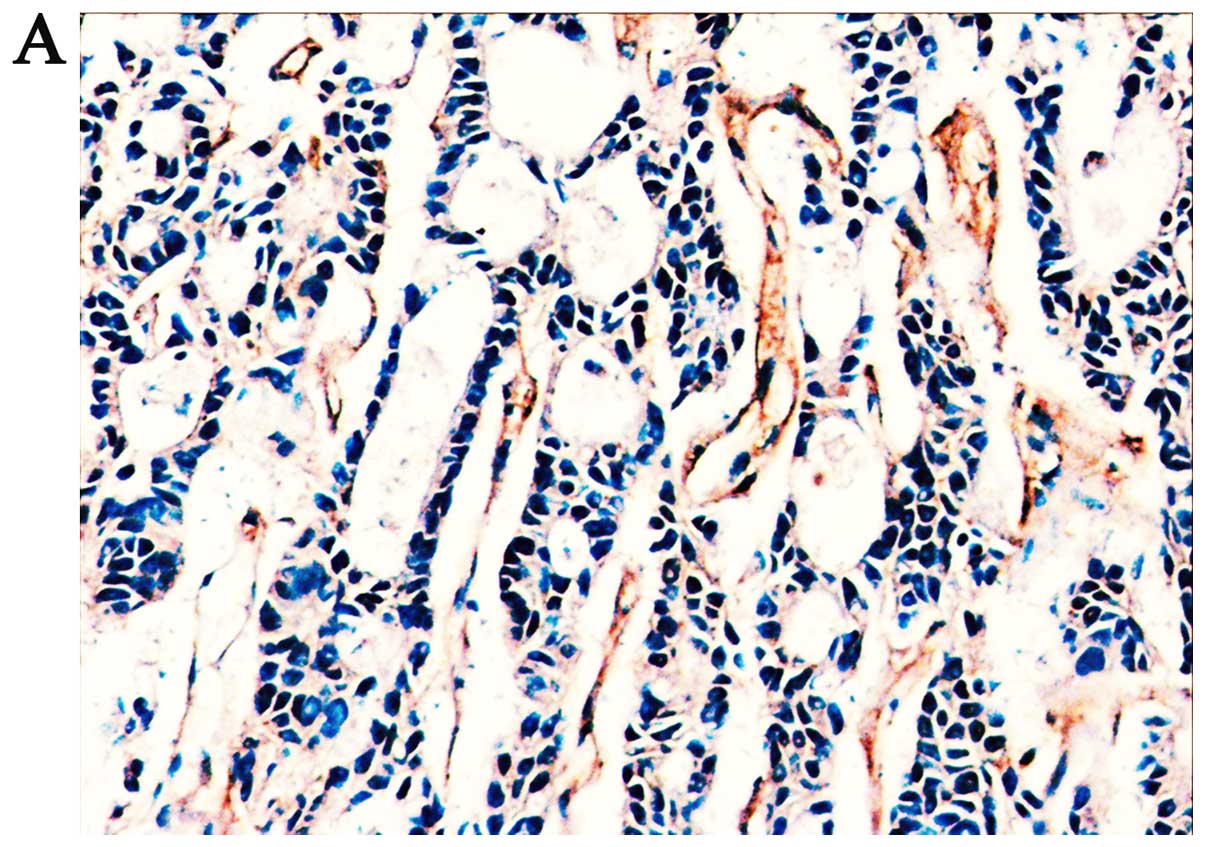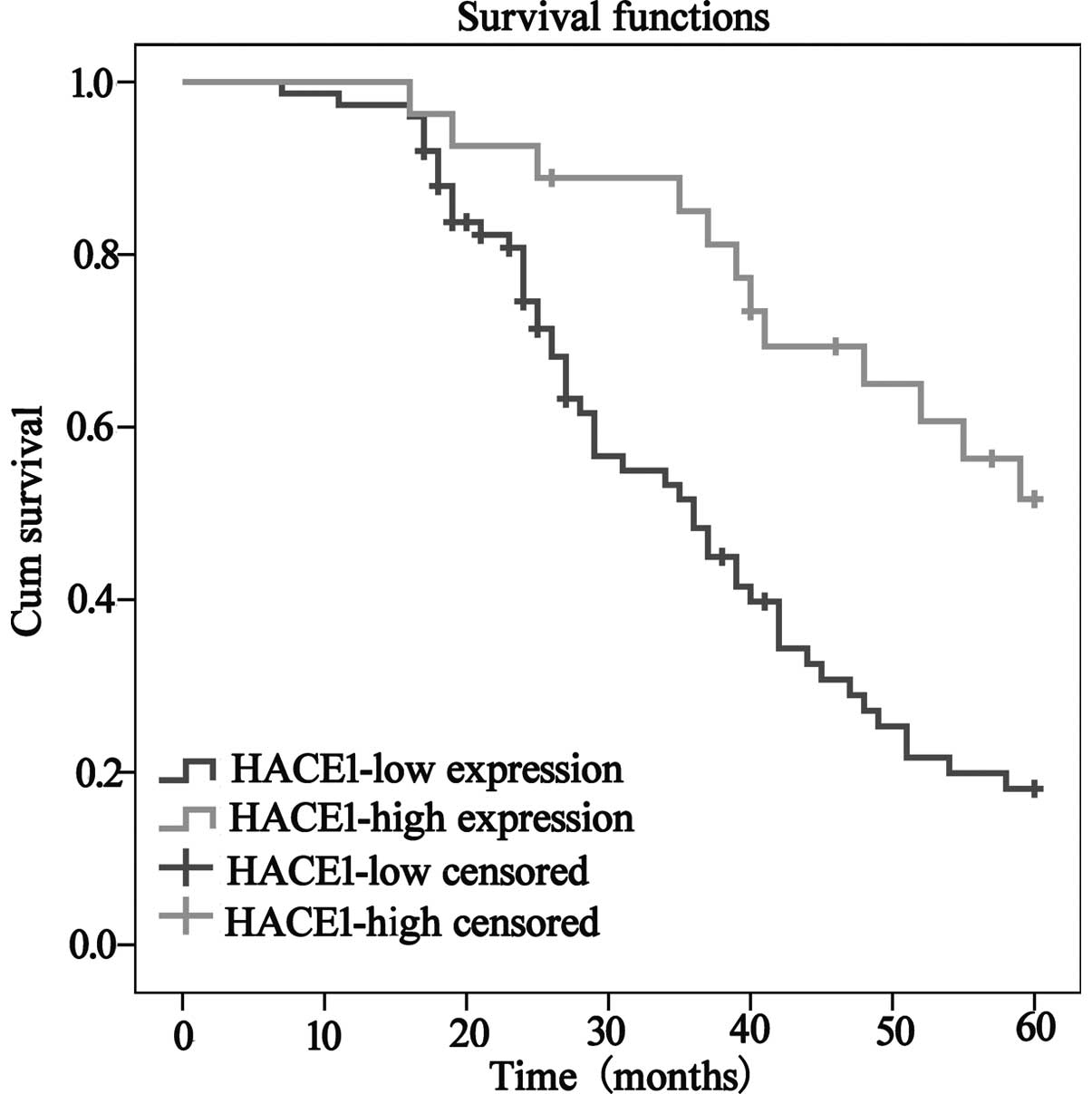Tumor-suppressive role of HACE1 in hepatocellular carcinoma and its clinical significance
- Authors:
- Published online on: October 26, 2016 https://doi.org/10.3892/or.2016.5205
- Pages: 3427-3435
Abstract
Introduction
Hepatocellular carcinoma (HCC) is one of the most common malignant tumors worldwide, and is a serious threat to human life. HCC has the second highest cancer mortality rate, next to lung cancer. Approximately 782,500 new liver cancer cases and 745,500 deaths occured worldwide in 2012, and most primary liver cancers occurring worldwide are HCC. China is a country with a high incidence of HCC, accounting for about 50% of the total number of cancer cases and deaths (1). Surgical and liver transplantation are still the best treatment option for suitable patients (2–4). However, most HCC cases are diagnosed at the advanced or unresectable stage. Given the poor prognosis of HCC, new therapeutic strategies and novel therapeutic targets are needed, respectively. But current research on the main pathogenic genes and molecular mechanisms of HCC remain unclear. In addition, coupled with the existence of an ageing population and pollution of the environment, we are faced with the increasingly serious situation of HCC. Therefore, the research for pathogenic genes and molecular mechanisms of HCC play a key role in the prevention and treatment of HCC.
HECT domain and ankyrin repeat containing E3 ubiquitin protein ligase 1 (HACE1) is located on chromosome 6q21 which is one site of frequent mutation of malignant tumors (5–8). HACE1 is an important tumor-suppressor gene, which plays an important role in tumor inhibition by mediating cell autophagy, Rac1 ubiquitination and other mechanisms. It is also involved in a variety of biological functions including heart protection, anti-oxidative stress and cellular dynamics (9–13). HACE1 gene was firstly discovered as closely related to the occurrence of Wilms' tumor (5). Futhermore, more evidence demonstrated that lower expression or mutations of HACE1 are associated with a variety of human malignant tumors, including breast cancer, colorectal cancer and lymphomas (14–16). However, there have been few available data concerning the precise function of the HACE1 gene in HCC.
In the present study, we investigated the expression of HACE1 in human HCC tissues and cell lines compared with matched adjacted non-tumor HCC tissues and the normal liver cell line L02. Immunohistochemistry (IHC) was performed to analyze the correlation of HACE1 expression with the clinicopathological features of patients. In addition, Cell Counting Kit-8 (CCK-8), Transwell and wound healing assays were applied to ascertain the role of HACE1 in the proliferation and migration of the HCC cell lines SMCC7721 and Huh7.
Materials and methods
Patient tissue samples
A total of 40 paired tumor and their adjacted non-tumor tissues were collected from HCC patients who underwent routine surgical resection at The First Hospital of Lanzhou University from 2007 to 2010. The fresh tissues were instantly frozen in liquid nitrogen and subsequently stored at −80°C until RNA and protein extraction for reverse-transcription quantitative polymerase chain reaction. In order to determine the relationships between HACE1 and the clinicopathological characteristics of HCC, an additional 102 paraffin-embedded archived specimens from patients who had undergone surgical resection were incorporated into the study for IHC. These patients included 82 males and 20 females, aged between 30 and 78 years, and the median patient age was 49 years. Histology of the tumor tissues was evaluated by two independent pathologists who were blinded to our examination. The clinicopathological information of all patients were collected for analysis, including age, gender, serum AFP, ALT level, tumor size, tumor number, vascular invasion, HBsAg, tumor differentiation, Child-Pugh and liver cirrhosis. The present study was approved by the Ethics Committee of The First Hospital of Lanzhou University prior to the initiation of the study.
Cell lines and culture
The human HCC cell lines Huh7, MHCC97H, HepG2, MHCC97L, HCCLM3, SMCC7721 and liver cell line L02 were obtained from the Cell Bank of the Chinese Academy of Sciences (Shanghai, China). All cell lines were cultured in Dulbecco's modified Eagle's medium (DMEM), supplemented with 10% fetal bovine serum (FBS) and 100 U/ml penicillin and 100 mg/ml streptomycin (all from Gibco, Shanghai, China). The cells were grown at 37°C in a humidified atmosphere of 5% CO2. The medium was changed every 2–3 days. Before further experiments, the protein and mRNA expression levels of HACE1 in the human HCC cell lines were examined by western blot analysis and quantitative real-time polymerase chain reaction (qRT-PCR), respectively. According to the experimental results, we chose the SMCC7721 and Huh7 cell lines for subsequent experiments.
Cell infection
The Huh7 cells were cultured to 50–60% confluency in 6-well plates and were transiently transfected with siRNA of HACE1 or negative control (NC) siRNA (GeneChem, Shanghai, China) using Lipofectamine 2000 (Invitrogen, Carlsbad, CA, USA) in accordance with the manufacturer's instructions for HACE1 knockdown. HACE1 siRNAs were: GGGCUACAAUGGGAAUAAAdTdT (si-HACE1-1), GCCCGAGGAUAAUGAAACUdTdT (si-HACE1-2), GCCA GUACCUAAAGAUUCUdTdT (si-HACE1-3). The SMCC7721 cells were transfected with pcDNA3.1-HACE1 or mock plasmid (GeneChem) using Lipofectamine 2000 transfection reagent according to the manufacturer's instructions for HACE1 overexpression. The transfection efficiency of both Huh7 and SMCC7721 cells was evaluated using qRT-PCR and western blot analysis. After 36 h of incubation, the cells were harvested for further analysis. All transfections were performed in triplicates.
qRT-PCR
Total RNA from tissues and all 7 cell lines were extracted using TRIzol reagent (Takara, Dalian, China), according to the manufacturer's instructions. The RNA concentration was detected by NanoDrop 1000 (Thermo Fisher Scientific, Wilmington, DE, USA) and complementary DNA was synthesized utilizing a PrimeScript RT reagent kit (Takara) using 2 µg RNA. SYBR-Green dye (Takara) and Corbet Rotor-Gene 3000 thermocycler were used to perform the qRT-PCR reaction, according to the supplied protocol. The primers used were as follows: HACE1 forward, 5′-TCCTTGAATGTCCTGAGTTGA-3′ and reverse, 5′-AATCTGGCTGTCCTGAATGC-3′; and GAPDH forward, 5′-GGCATCCTGGGCTACACTGA-3′ and reverse, 5′-GTGGTCGTTGAGGGCAATG-3′. The amplification conditions of qRT-PCR were set as follows: 95°C for 30 sec, 95°C for 5 sec, 60°C for 34 sec, 95°C for 15 sec and a total of 40 cycles. The experiments were repeated in triplicate. Relative expression levels of HACE1 were normalized to GAPDH expression in each sample, and the data were analyzed according to the comparative threshold cycle (2−ΔΔCt) method.
Protein extraction and western blot analysis
Total protein of human HCC tissues and cells were extracted using ice-cold lysis buffer (50 mM Tris, pH 7.4, 150 mM NaCl, 1% SDS, 1 mM EDTA, 1% NP-40) containing 1 mM protein inhibitor and 1 mM PMSF, for 30 min on ice. The lysates were centrifuged at 12,000 rpm at 4°C for 15 min and the supernatants were collected. Protein concentration was determinated using the BCA protein assay (Beyotime, Shanghai, China). Protein samples (50 µg/lane) were separated by electrophoresis on 10% sodium dodecyl sulphate-polyacrylamide gel electrophoresis (SDS-PAGE) and then transferred onto polyvinylidene difluoride (PVDF) membrane filters (Millipore Corp., Billerica, MA, USA) in a wet transfer system (Bio-Rad, Berkeley, CA, USA). PVDF membranes were blocked with 2% BSA for 1 h at room temperature. Membranes were incubated with anti-human HACE1 antibody (1:2,000 dilution; Abcam, Cambridge, UK) overnight at 4°C. The membranes were then incubated with the corresponding secondary antibody (1:5,000) for 1 h at room temperature. The immunoreactive bands were visualized using enhanced chemiluminescence (ECL) reagent (Thermo Fisher Scientific, Israel), and the relative protein expression of the membranes was then normalized to the β-actin levels.
Cell proliferation assay
The CCK-8 assay (Dojindo Laboratories, Kunamoto, Japan) was used to reflect the proliferation of the cells. For the CCK-8 assay, ~5,000 viable cells were placed into 96-well plates at a final volume of 100 µl for each well. Every 24 h, 10 µl of CCK-8 solution was added to each well, and the plate was further incubated for 2 h at 37°C. The absorbance at 450 nm was quantitated with a microplate reader. The experiment was performed in 6 replicates.
Cell migration assay
Transwell and wound healing assays were used to evaluate the cell migration capability. The Transwell and migration assays were performed using a 24-well plate, and a Transwell chamber with a polycarbonate filter membrane (Corning Inc., Corning, NY, USA) was placed in the 24-well plate, and the pore size of the filter membrane size was 8 µm. Firstly, digested cells (5×103/chamber) with 200 µl serum-free media were added to the upper compartment, and 400 µl DMEM containing 10% FBS was added to the lower compartment, and further incubated for 24 h at 37°C. After incubation, the cells in the upper chamber migrated to the lower surface of the membrane. The cells on the upper membrane were removed carefully with a cotton tip and the penetrated polycarbonic membrane was fixed with 95% methanol and stained with 0.1% crystal violet. The number of migrated cells was counted in 6 randomly selected fields under an inverted microscope. Independent experiments were performed in triplicate. For the wound healing assay, tumor cells were seeded in a 6-well plate at a density and incubated to 70–80% confluency as a monolayer. A cell-free straight line was scratched in the center of the well with a sterile 200-µl pipette tip. Similarly, a second straight line was created perpendicular to the first line to produce a cross-shaped cellular gap in each well. The cells were subsequently washed twice with phosphate-buffered saline (PBS) and refreshed with medium containing 5% FBS. The cells were grown for an additional 72 h. Digital images of the cell gap were captured at different time points using a microscope. The gap distance was quantitatively assessed using software.
Immunohistochemistry
The relationships between HACE1 expression and clinicopathological characteristics of the HCC patients was analyzed using 4-µm paraffin-embedded specimens by IHC. After incubation at 60°C for 30 min, all tissue sections were deparaffinized in xylene, and then rehydrated by graded ethanol solutions before sodium citrate buffer (pH 6.0) was used as an antigen retrieval solution. Endogenous peroxidase activity was blocked with 0.3% hydrogen peroxide in a humidified chamber for 15 min. After washing for three times, the specimens were incubated with rabbit monoclonal antibody against human HACE1 (1:200, ab18056; Abcam) at 4°C overnight. Following washing with PBS for three times, the tissue sections were incubated with a horseradish peroxidase-labeled secondary antibody for 1 h at room temperature. The specimens were incubated with 3,3′-diaminobenzidine (DAB) solution for 3 min. Finally, the sections were counterstained with hematoxylin. The primary antibody was replaced by PBS as a NC. Tissue specimens were assessed separately by two pathologists who were blinded to any information about the patient background or clinical status. The percentage of positive staining was scored as follows: 1 point (0–25%, weakly stained); 2 points, (>25–50%, moderately stained); and 3 points (>50%, strongly stained). The HACE1 immunostaining score was calculated from the product of the percent positivity score × the staining intensity score which ranged from 0 to 9. Low HACE1 expression level was defined as a total score of <5, and high HACE1 expression was defined as a total score of ≥5.
Statistical analysis
All statistical analysis was performed using SPSS 21.0 software. The relationships between HACE1 expression and clinicopathological characteristics were analyzed using the χ2 test. Student's t-test was used to compare the statistical significance in the various groups. Survival curves were calculated using the Kaplan-Meier method and the result was compared using the log-rank test. Cox's proportional hazard analysis was used to explore univariate and multivariate survival. A difference was considered statistically significant at P<0.05.
Results
Expression of HACE1 protein and mRNA in HCC and paired adjacent non-tumor tissues
The expression of HACE1 was markedly lower in the HCC tissues compared to that noted in the matched adjacent non-tumor tissues at both the protein and mRNA levels. The HACE1 protein and mRNA expression in 40 HCC specimens and their adjacent non-tumor tissues were evaluated by western blot analysis and qRT-PCR. HACE1 mRNA expression level of HACE1 was lower in 32 of the 40 HCC samples (80%) than in the adjacent non-tumor tissues (P<0.01; Fig. 1A). The protein expression of HACE1 was decreased in 30 of the 40 HCC samples (75%), compared with the matched adjacent non-tumor tissues (P<0.001; Fig. 1B and C).
Expression of HACE1 protein and mRNA in HCC cell lines
We assessed the HACE1 gene expression in HCC cell lines by western blot analysis and qRT-PCR. Western blot analysis and qRT-PCR determined that HACE1 mRNA (Fig. 2A) and protein expression (Fig. 2B) were significantly decreased in the 6 HCC cell lines compared with the expression levels in the normal liver cell line L02. As shown in Fig. 2, the highest expression of the HACE1 gene was detected in Huh7 cells, and the lowest was detected in the SMCC7721 cells among all HCC cell lines. Therefore, to verify the role of HACE1 in the HCC cell lines, we upregulated HACE1 by transfection of pcDNA3.1-HACE1 into the SMCC7721 cells and Huh7 cells were transfected with siRNA targeting HACE1 for downregulation.
Knockdown and overexpression efficiency as determined by western blot analysis and qRT-PCR
To explore the role of HACE1, we knocked down the HACE1 gene in the human HCC Huh7 cell line and overexpressed HACE1 in the HCC SMCC7721 cell line, respectively. As shown in Fig. 3A and B, by day 2 post infection, HACE1 protein and mRNA levels of HACE1-siRNA-infected Huh7 cells were significantly lower compared to levels in the cultures infected with the NC siRNA by western blot analysis and qRT-PCR. The highest knockdown efficiency of HACE1 siRNA was siRNA-3 and thus siRNA-3 was used in the subsequent experiment (P<0.001). Similarly, HACE1 mRNA and protein levels of pcDNA3.1-HACE1-infected SMCC7721 cell line were significantly higher compared to levels in the cultures infected with the mock plamid as a control (P<0.01; Fig. 3C and D).
Effect of the knockdown and overexpression of HACE1 on cellular proliferation and migration in the Huh7 and SMCC7721 cell lines
To evaluate the role of HACE1 in HCC proliferation and migration, two different types of cells were examined by CCK-8, Transwell and wound healing assays. The results indicated that downregulation of HACE1 expression significantly inhibited the proliferation and migration of the Huh7 cells (P<0.05; Fig. 4A-C), and upregulation of HACE1 expression obviously promoted the proliferation and migration of the SMCC7721 cells (P<0.05; Fig. 4D-F).
Correlation between HACE1 expression and clinicopathological characteristics
We explored the correlation of HACE1 expression and the clinicopathological characteristics of the 102 HCC patients based on IHC analysis (Fig. 5) and the results are summarized in Table I. From the results, we found that 75 samples (73.52%) had low HACE1 expression, and 27 samples (26.48%) had high HACE1 expression. According to the level of HACE1 expression in the tumor tissues, we demonstrated that a low level of HACE1 expression was significantly associated with serum AFP level (P<0.001), tumor differentiation (P<0.05) and vascular invasion (P<0.05). Overall survival was significantly decreased in the patients with low HACE1 expression compared to patients with high HACE1 expression (Fig. 6). In addition, univariate and multivariate Cox regression analyses demonstrated that AFP level, tumor differentiation, Child-Pugh and HACE1 level were significantly associated with overall survival and were significant prognostic factors for HCC patients (Table II).
Table I.Correlation between HACE1 expression and clinicopathological characteristics of the HCC cases (n=102). |
Discussion
Genomic losses or low expression in relation to human chromosome 6q21 have been described for a wide spectrum of tumor types including lung or breast cancer, as well as ovarian and gastric cancers (6,17,18), suggesting that this region encompasses one or more major tumor-suppressor genes. The HACE1 gene encodes a 103-kDa protein containing six N-terminal ankyrin repeats connected via a linker region to a C-terminal HECT domain (19). The expression of the 6q21 HACE1 gene is downregulated in multiple human tumor types involving Wilms' tumor, breast cancer and lung carcinoma (20–23). Findings of previous studies have demonstrated that HACE1 lower expression or deletion, as caused by HACE1 ubiquitination or methylation, is related to the occurrence and invasion in different types of carcinomas (10,24,25). It was revealed that HACE1 is a new type of candidate anti-oncogene and perhaps a therapeutic target for several types of human cancers. However, to the best of our knowledge, the expression of HACE1 and its possible role in the anticancer effects on hepatocellular carcinoma have not been discussed to date.
In the present study, we firstly found that the HACE1 expression level was downregulated at both the mRNA and protein levels in HCC tissues and HCC cell lines when compared with these levels in adjacent non-tumor tissues and a normal cell line L02 as analyzed by qRT-PCR and western blot analysis. Thus, we assumed that HACE1 plays an important role in tumor proliferation and migration. To explore this issue, CCK-8, Transwell and wound healing assays were performed. The result demonstrated that overexpression of HACE1 by transfection with pcDNA3.1-HACE1 in SMCC7721 cells led to lower proliferation and migration ability compared to the control group. In addition siRNA-mediated HACE1 knockdown in Huh7 cells significantly accelerated cell proliferation and migration. The downregulation of HACE1 expression correlated with the serum AFP level, tumor differentiation and vascular invasion in HCC patients. Survival analyses exhibited that patients with a low HACE1 expression showed poorer overall survival than those with a high HACE1 expression, and the status of HACE1 expression was an independent prognostic factor.
In conclusion, we provided strong evidence that HACE1 was significantly downregulated in HCC cell lines and HCC tissues. Moreover, the expression of HACE1 in HCC tissues was associated with the development, progression and metastasis of HCC or prognosis of the patients by regulating the proliferation and migration of HCC cells. IHC analysis suggested that the expression of HACE1 in HCC tissues was associated with serum AFP level, tumor differentiation and vascular invasion. Survival analyses demonstrated that patients with low HACE1 expression exhibited poorer overall survival than those with high HACE1 expression, and the level of HACE1 expression was an independent prognostic factor.
In addition, in vitro studies showed that overexpression of HACE1 decreased the proliferation and migration ability in the human HCC cell line SMCC7721. On the contrary, HACE1 knockdown in human cell line Huh7 facilitated the proliferation and migration ability. Yet, further exploration is required to elucidate the signaling pathways and molecular mechanism of HACE1 in HCC, which may be useful in acquiring better understanding of the molecular pathogenesis of these tumors. Taken together, the results suggest that, as a tumor-suppressor, HACE1 can be used to develop more effective targeted therapeutic strategies and may be a potential therapeutic target for HCC treatment.
Acknowledgements
This study was supported by grants from the National Natural Science Foundation of China (grant nos. 31270543 and 81101818) and Fundamental Research Funds for the Central Universities (lzujbky-2013-k21).
References
|
Torre LA, Bray F, Siegel RL, Ferlay J, Lortet-Tieulent J and Jemal A: Global cancer statistics, 2012. CA Cancer J Clin. 65:87–108. 2015. View Article : Google Scholar : PubMed/NCBI | |
|
Waller LP, Deshpande V and Pyrsopoulos N: Hepatocellular carcinoma: A comprehensive review. World J Hepatol. 7:2648–2663. 2015. View Article : Google Scholar : PubMed/NCBI | |
|
Liccioni A, Reig M and Bruix J: Treatment of hepatocellular carcinoma. Dig Dis. 32:554–563. 2014. View Article : Google Scholar : PubMed/NCBI | |
|
Waghray A, Murali AR and Menon KN: Hepatocellular carcinoma: From diagnosis to treatment. World J Hepatol. 7:1020–1029. 2015. View Article : Google Scholar : PubMed/NCBI | |
|
Anglesio MS, Evdokimova V, Melnyk N, Zhang L, Fernandez CV, Grundy PE, Leach S, Marra MA, Brooks-Wilson AR, Penninger J, et al: Differential expression of a novel ankyrin containing E3 ubiquitin-protein ligase, Hace1, in sporadic Wilms' tumor versus normal kidney. Hum Mol Genet. 13:2061–2074. 2004. View Article : Google Scholar : PubMed/NCBI | |
|
Zhang L, Anglesio MS, O'Sullivan M, Zhang F, Yang G, Sarao R, Mai PN, Cronin S, Hara H, Melnyk N, et al: The E3 ligase HACE1 is a critical chromosome 6q21 tumor suppressor involved in multiple cancers. Nat Med. 13:1060–1069. 2007. View Article : Google Scholar : PubMed/NCBI | |
|
Qu Y, Dang S and Hou P: Gene methylation in gastric cancer. Clin Chim Acta. 424:53–65. 2013. View Article : Google Scholar : PubMed/NCBI | |
|
Sako N, Dessirier V, Bagot M, Bensussan A and Schmitt C: HACE1, a potential tumor suppressor gene on 6q21, is not involved in extranodal natural killer/T-cell lymphoma pathophysiology. Am J Pathol. 184:2899–2907. 2014. View Article : Google Scholar : PubMed/NCBI | |
|
Liu Z, Chen P, Gao H, Gu Y, Yang J, Peng H, Xu X, Wang H, Yang M, Liu X, et al: Ubiquitylation of autophagy receptor Optineurin by HACE1 activates selective autophagy for tumor suppression. Cancer Cell. 26:106–120. 2014. View Article : Google Scholar : PubMed/NCBI | |
|
Mettouchi A and Lemichez E: Ubiquitylation of active Rac1 by the E3 ubiquitin-ligase HACE1. Small GTPases. 3:102–106. 2012. View Article : Google Scholar : PubMed/NCBI | |
|
Zhang L, Chen X, Sharma P, Moon M, Sheftel AD, Dawood F, Nghiem MP, Wu J, Li RK, Gramolini AO, et al: HACE1-dependent protein degradation provides cardiac protection in response to haemodynamic stress. Nat Commun. 5:34302014.PubMed/NCBI | |
|
Deng S and Huang C: E3 ubiquitin ligases in regulating stress fiber, lamellipodium, and focal adhesion dynamics. Cell Adhes Migr. 8:49–54. 2014. View Article : Google Scholar | |
|
Castillo-Lluva S, Tan CT, Daugaard M, Sorensen PH and Malliri A: The tumour suppressor HACE1 controls cell migration by regulating Rac1 degradation. Oncogene. 32:1735–1742. 2013. View Article : Google Scholar : PubMed/NCBI | |
|
Goka ET and Lippman ME: Loss of the E3 ubiquitin ligase HACE1 results in enhanced Rac1 signaling contributing to breast cancer progression. Oncogene. 34:5395–5405. 2015. View Article : Google Scholar : PubMed/NCBI | |
|
Huang Y, de Reyniès A, de Leval L, Ghazi B, Martin-Garcia N, Travert M, Bosq J, Brière J, Petit B, Thomas E, et al: Gene expression profiling identifies emerging oncogenic pathways operating in extranodal NK/T-cell lymphoma, nasal type. Blood. 115:1226–1237. 2010. View Article : Google Scholar : PubMed/NCBI | |
|
Hibi K, Sakata M, Sakuraba K, Shirahata A, Goto T, Mizukami H, Saito M, Ishibashi K, Kigawa G, Nemoto H, et al: Aberrant methylation of the HACE1 gene is frequently detected in advanced colorectal cancer. Anticancer Res 28 (3A). 1581–1584. 2008. | |
|
Hudson C, Schwanke C, Johnson JP, Elias AF, Phillips S, Schwalbe T, Tunby M and Xu D: Confirmation of 6q21-6q22.1 deletion in acro-cardio-facial syndrome and further delineation of this contiguous gene deletion syndrome. Am J Med Genet A 164A. 2109–2113. 2014. View Article : Google Scholar | |
|
Wang XC, Zhang JQ, Shen YQ, Miao FQ and Xie W: Loss of heterozygosity at 6p21.3 underlying HLA class I downregulation in gastric cancer. J Exp Clin Cancer Res. 25:115–119. 2006.PubMed/NCBI | |
|
Scheffner M and Kumar S: Mammalian HECT ubiquitin-protein ligases: Biological and pathophysiological aspects. Biochim Biophys Acta. 1843:61–74. 2014. View Article : Google Scholar : PubMed/NCBI | |
|
Stewénius Y, Jin Y, Ora I, Panagopoulos I, Möller E, Mertens F, Sandstedt B, Alumets J, Akerman M, Merks JH, et al: High-resolution molecular cytogenetic analysis of Wilms tumors highlights diagnostic difficulties among small round cell kidney tumors. Genes Chromosomes Cancer. 47:845–852. 2008. View Article : Google Scholar : PubMed/NCBI | |
|
Capasso M, Diskin S, Cimmino F, Acierno G, Totaro F, Petrosino G, Pezone L, Diamond M, McDaniel L, Hakonarson H, et al: Common genetic variants in NEFL influence gene expression and neuroblastoma risk. Cancer Res. 74:6913–6924. 2014. View Article : Google Scholar : PubMed/NCBI | |
|
Capasso M, Diskin SJ, Totaro F, Longo L, De Mariano M, Russo R, Cimmino F, Hakonarson H, Tonini GP, Devoto M, et al: Replication of GWAS-identified neuroblastoma risk loci strengthens the role of BARD1 and affirms the cumulative effect of genetic variations on disease susceptibility. Carcinogenesis. 34:605–611. 2013. View Article : Google Scholar : PubMed/NCBI | |
|
Küçük C, Hu X, Iqbal J, Gaulard P, Klinkebiel D, Cornish A, Dave BJ and Chan WC: HACE1 is a tumor suppressor gene candidate in natural killer cell neoplasms. Am J Pathol. 182:49–55. 2013. View Article : Google Scholar : PubMed/NCBI | |
|
Gacon G, Mettouchi A and Lemichez E: The tumor suppressor HACE1 targets Rac1 to ubiquitin-mediated proteasomal degradatio]. Med Sci (Paris). 28:39–41. 2012.(In French). View Article : Google Scholar : PubMed/NCBI | |
|
Lachance V, Degrandmaison J, Marois S, Robitaille M, Génier S, Nadeau S, Angers S and Parent JL: Ubiquitylation and activation of a Rab GTPase is promoted by a β2AR-HACE1 complex. J Cell Sci. 127:111–123. 2014. View Article : Google Scholar : PubMed/NCBI |



